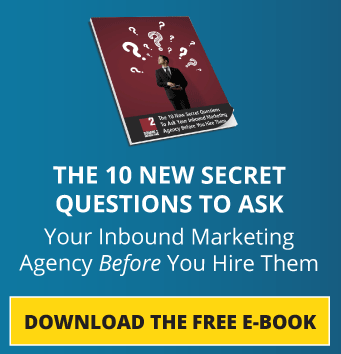
Rethink Your Content Marketing Strategy to Optimize the Buyer Journey
Content Marketing Just Got A Whole Lot More Complicated
 We’ve been providing content marketing strategy and content marketing services for clients since we opened our doors in 2003. By far, one of the most common questions from prospects and clients is, “How much content do we need and what should our content say?” In other words, they want to know what content to create and how frequently to create it.
We’ve been providing content marketing strategy and content marketing services for clients since we opened our doors in 2003. By far, one of the most common questions from prospects and clients is, “How much content do we need and what should our content say?” In other words, they want to know what content to create and how frequently to create it.
I think this is an industrywide challenge. Agencies don’t know the answer to these questions, so in general, they answer with “more!” The more content, the better. They typically handle the “what to create” part by trying to identify the questions prospects are asking and then attempting to answer those questions with content.
Both approaches are reasonable (even though they are simplistic and generic), and while they might move the needle, today a much more scientific and effective approach exists for answering these important content marketing questions.
They key is better understanding the prospect journey and the role content plays in helping prospects move through their journey.
Content To Disrupt, Connect And Engage
Right now, prospects are unaware that you, your company, your products and your services even exist. This is why people advertise, make cold calls, send cold emails, go to trade shows and now do account-based marketing. They are attempting to “get in front” of the right people. Targeting the companies and the people in those companies has never been easier, but knowing what to say to get their attention in an increasingly cluttered world is a big challenge.
Assuming you figure out a disruptive, compelling and emotional message to get their attention with, this only produces a new contact. To get your contact to consider starting a buyer journey, you’ll need to engage that person in a conversation, and that’s going to require high-value content. Your first piece of content needs to get them to say, “Hmmmm, I really need to look into this more. We might need this at our company, and it’s my job to explore this for us.”
This is going to be one of the most important content decisions within your overall content strategy. It’s going to set the tone for your ongoing content conversation with your prospects, set the stage for your company’s overall thought leadership and drive new leads at the early stages of the buyer journey.
Content To Capture Awareness
 Now that people are aware of you, it’s like taking the first step in a long journey. People in the awareness stage of their buyer journey are not active; they’re just aware. It means their brain is tuned into the idea. Technically, it means the reticular activating system (RAS), a bundle of nerves at our brainstem, is filtering out unnecessary information so the important stuff gets through.
Now that people are aware of you, it’s like taking the first step in a long journey. People in the awareness stage of their buyer journey are not active; they’re just aware. It means their brain is tuned into the idea. Technically, it means the reticular activating system (RAS), a bundle of nerves at our brainstem, is filtering out unnecessary information so the important stuff gets through.
We’ve all experienced this feeling. The RAS is the reason you learn a new word and then start hearing it everywhere. It’s why you can tune out a crowd full of talking people, yet immediately snap to attention when someone says your name or something that at least sounds like it. It’s how you’ll notice ads you’ve never noticed before and, if you’re engaged, click on those ads and be open to the messages, content and offers associated with that marketing.
Content in the awareness stage must continue the conversation from the initial disruptive engagement stage we call pre-awareness. If it’s high quality, it cuts through the clutter like a knife.
It also should be strategically designed and written to move people into education, which includes an additional characteristic — activity. This means content in this stage needs to be equally disruptive. Motivating people to act requires strong arguments as to why action is necessary, high degrees of fear, uncertainty or doubt, and a healthy dose of FOMO (fear of missing out).
Content To Educate
People who are ready to learn consume content differently than people in both of the earlier stages. Now you need content designed for their learning style, you need content presented in binge-worthy delivery formats, you need content that might be role or vertically focused and you need content that is deep enough to support people who require a ton of education to feel comfortable.
For example, visual learners need videos. Right-brain people need pictures and images, like infographics. Left-brain people need data and research studies, like whitepapers and e-books. Some people like to listen and digest content via podcasts and audio recordings. Some people like books, while others prefer short tip guides. Finally, some people prefer experiential learning, like trade shows, conferences, events and live training sessions.
Your persona work needs to uncover and extend well beyond the typical demographic. You must push into the psychographic profiling of a target prospect’s typical learning style, and then adjust the content strategy accordingly.
Content To Aid In Consideration
 While prospects in the education stage are active in their desire to learn, prospects in the consideration stage have decided they are going to do something. They just don’t know what yet, and their journey now switches gears as they start to narrow down their options. They may decide to do nothing in the end, but for now they’re ready to start looking at options.
While prospects in the education stage are active in their desire to learn, prospects in the consideration stage have decided they are going to do something. They just don’t know what yet, and their journey now switches gears as they start to narrow down their options. They may decide to do nothing in the end, but for now they’re ready to start looking at options.
Content for people in this stage needs to help them identify the options — all of them. It has to help them understand the pluses and minuses of those options. You can think about this like people who submit their RFPs to the long list of candidates with the understanding that they’ll narrow it down to their top three by reviewing the RFP responses. This is the stage where the long list gets put together.
Your content needs to be designed to make sure you get on the long list and that your competitors don’t. You need to educate the prospect as to why certain options should not be considered, why certain competitors should not be considered and why they should start making a more emotional connection with your company. Sometimes it’s during this stage where the handoff from marketing to sales takes place.
Content To Aid In Evaluation
At this stage, you’re talking about prospects who have narrowed down their options (typically to their top three), and this is where sales is asked to get involved. If the handoff from marketing to sales didn’t take place in the consideration stage, it’s going to take place in this stage, and your content has to be designed accordingly.
 Here, content strategy needs to adjust to helping prospects understand the differences between their three or four options. For example, we publish a piece of content that’s called, “The 10 New Secret Questions To Ask Your Inbound Marketing Agency Before You Hire Them.”
Here, content strategy needs to adjust to helping prospects understand the differences between their three or four options. For example, we publish a piece of content that’s called, “The 10 New Secret Questions To Ask Your Inbound Marketing Agency Before You Hire Them.”
This is going to help prospects better vet their agency choices, ask tougher questions and make better decisions.
This is a tough part of the process, and the more ammunition you can provide your prospects to help them make an easier, safer, smarter and more efficient decision around which path to take, the more value you’ll be introducing into the buyer journey. This means a tighter emotional bond between you and the prospects, and that usually means you’ll be the first choice.
Content To Help Rationalization
Moving into this stage means they’ve already made their emotional choice. They want to do business with you, but there’s still work to be done. They might have to sell it up the food chain and make a presentation to the CEO or the board.
They might have to put a business case together for the finance committee. Now that they have the pricing and investment level, they still need additional information around contracts, delivery, team configuration, payment terms, etc. A lot of details still need to be discussed and agreed on.
People make purchase decisions emotionally and then rationalize those decisions later. Consider your last furniture purchase (or any large purchase). You love the sofa. You can see your family snuggling on it watching a movie. Those are emotional feelings. Next, you have to rationalize the purchase. Can we afford it? Will it fit in our room? What is the shipping cost? When can we get it? What are the financing options? Your prospects are behaving the same way, and this stage is an important one.
You’ll need content for the sales team to deliver in context to the specific rationalization exercises your prospects are going through. You might need CEO-level presentation decks or content that talks about selling your ideas up the ladder. You might need detailed case studies or detailed delivery specks. An onboarding document might be relevant at this stage, too. Whatever they are going to need to feel safe about working with you must be flagged for creation and use during this stage.
Content That Drives Decisions

It’s hard work getting someone to say “yes” to your company, especially when we’re talking about high-ticket average sales and long sales cycles. These are complex times and complex decisions. It took a lot of work to get to the final decision-making stage, but you’re not done yet. You still need the final and official signature on the agreement, contract or proposal.
Yes, your agreement, contract or proposal is a piece of content that is getting delivered during this critical stage. If you send a 20-page legal document for a $2,000 sale, you might be sending a message unintentionally that your company is legally oriented and difficult to work with. Even if that is not your intention, people make assumptions from the agreement you put in front of them.
Make sure your paperwork, presentation or proposal is designed perfectly to fit your prospect and this stage in their buyer journey. They’re just as worn out as you are and just as excited to get started, so don’t put a ton of friction into the process now to slow anything down or make them nervous. Make this stage and the content you provide them as easy as possible to sign.
Ongoing Content During Delivery
It’s great to win the deal, but this is just the beginning of a long and profitable relationship between you and your new client. You’re not ending the content strategy here; you’re just shifting to content that promotes cross-sell, upsell and retention objectives into the current client base.
Revenue generation doesn’t just come from new clients; revenue also comes from current clients. Your content plan should be equally connected to continuing the conversation with current clients and educating them on everything you do, what’s available and the ease at which you can provide them additional products, services or solutions.
This is going to be especially important when we start talking about advocacy. You’re going to want your current clients to be extra happy with you, so they participate in any of the references, reviews or co-marketing activities you might ask them to participate in. The more active your current clients are in your marketing and sales efforts, the easier it’s going to be to hit your revenue goals.
What this approach uncovers is that you may need eight different types of content in your content marketing strategy. It means that all content is not created equally and is not deployed in a similar fashion. Content for the decision-making stage should be delivered through a sales guide, not a website form completion. Content designed to educate might be created differently than content designed to help people evaluate three different possible options.
As with all marketing and sales execution today, it just got exponentially more complicated. If you want to match your content strategy to the cyclones your prospects are currently spinning around in, you’re going to have to do a much better job of understanding that stage and the other elements influencing prospects during each stage. You’re also going to have to work a lot harder to create content that delivers the influence you need to move your prospects out of one stage and into the next stage.
Square 2 Marketing – Revenue Is Earned Through Experiences, Methodology And Insights!

CEO and Chief Revenue Scientist
Mike Lieberman, CEO and Chief Revenue Scientist
Eliminate Hit-or-Miss Marketing Moves
Get advice, tips, tools and guidance to generate more leads for your company in this weekly email newsletter.



Eliminate Hit-or-Miss Marketing Moves
Get advice, tips, tools and guidance to generate more leads for your company in this weekly email newsletter.













